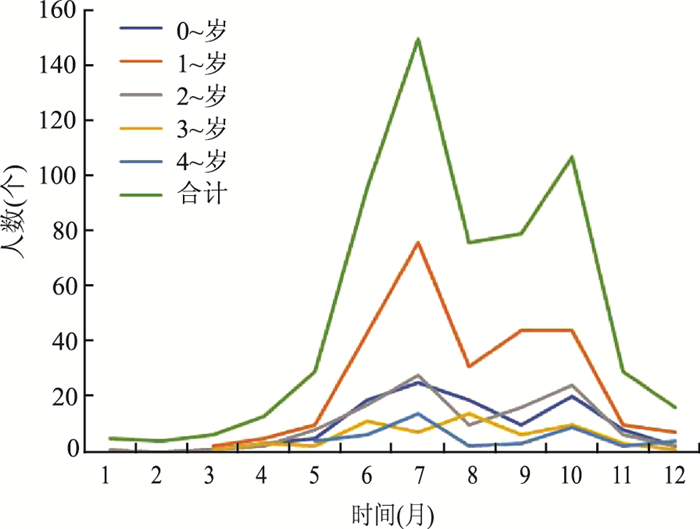Epidemiological characteristics and drug resistance surveillance of Shigella in infants and young children in Henan Province from 2013 to 2017
-
摘要:
目的 了解河南省2013-2017年婴幼儿志贺菌的病原学特征。 方法 以河南省5岁以下腹泻患儿5 149份粪便分离的606株志贺菌为研究对象,采用血清分型、药物敏感试验及聚合酶链式反应(polymerase chain reaction,PCR)检测毒力基因方法,对其进行病原学检测。 结果 儿童志贺菌总检出率为11.77%(606/5 149),1~岁年龄组幼儿检出率最高,为24.08%;606株志贺菌共分为2群、11种血清型,其中福氏志贺菌占73.43%,宋内志贺菌占26.57℅。176株志贺菌对氨苄西林、萘啶酸的耐药严重(耐药率>90%),对氯霉素、环丙沙星,诺氟沙星、复方新诺明的耐药率>65%,对亚胺培南和头孢类抗生素敏感度较高,且福氏与宋内志贺菌耐药有差异。婴幼儿毒力基因组合模式以shET-1+、shET-2+、ipaH+、ial+为主,并检出5株无毒力株。 结论 河南省婴幼儿细菌性痢疾以福氏志贺菌为主,对常用的抗生素存在严重的耐药问题,不同血清型菌株携带优势基因模式不同。 Abstract:Objective To investigate the pathogenic characteristics of Shigella in infants from 2013 to 2017 in Henan Province. Methods From 2013 to 2017, 606 Shigella strains were isolated from 5 149 children with diarrhea under 5 years old in Henan Province. Serotyping, drug sensitivity test and Polymerase Chain Reaction detection of virulence gene methods were used to detect the pathogen of Shigella. Results The detection rate of Shigella in children with diarrhea was 11.77%, and the highest detection rate was in the 1-2 age group(24.08%). 606 Shigella strains were divided into two groups and 11 serotypes. Shigella flexneri accounted for 73.43%, and Shigella sonnei accounted for 26.57%. Resistance of 176 Shigella strains to ampicillin and naphthidine was serious (resistance rate > 90%), and the resistance rates to chloramphenicol, ciprofloxacin, norfloxacin and compound sulfamethoxamine were higher than 65%, and the sensitivity of imipenem and cephalosporin were higher. There were differences in drug resistance between Shigella flexneri and Shigella sonnei. The virulence genes of infants were mainly shET-1+, shET-2+, ipaH+ and ial+, and 5 avirulent strains were detected. Conclusions The bacterial dysentery of infants in Henan Province is dominated by Shigella flexneri. There are serious resistance and multidrug resistance to common antibiotics, and the dominant genes in different serotyping strains are different. -
Key words:
- Infant /
- Shigella /
- Surveillance /
- Serotyping /
- Drug resistance /
- Virulencegenes
-
表 1 2013-2017年腹泻患儿志贺菌检出情况
Table 1. Shigella detection in children with diarrhea from 2013 to 2017
年龄组(岁) 2013年 2014年 2015年 2016年 2017年 合计 采样数(株) 检出菌株数(株) 采样数(株) 检出菌株数(株) 采样数(株) 检出菌株数(株) 采样数(株) 检出菌株数(株) 采样数(株) 检出菌株数(株) 采样数(株) 检出菌株数(株) 0~ 382 31 353 25 345 30 486 15 386 11 1 952 112 1~ 186 53 230 62 229 75 249 54 244 30 1 138 274 2~ 137 22 154 30 154 36 146 8 143 19 734 115 3~ 140 16 131 9 130 19 239 6 138 8 678 58 4~ 127 8 135 11 126 13 132 7 127 8 647 47 合计 972 130 1 003 137 984 173 1 152 90 1 038 76 5 149 606 表 2 2013-2017年幼儿分离株血清型(株)及构成比[n(%)]
Table 2. Serotypes (strains) and constituent ratios (%) of infant isolates[n(%)]
血清分型 2013年 2014年 2015年 2016年 2017年 合计 B群 F1a 16(12.31) 15(10.95) 18(10.40) 9(10.00) 7(9.21) 65(10.73) F2a 80(61.54) 57(41.61) 70(40.46) 32(35.56) 44(57.89) 283(46.70) F2b 8(6.15) 2(1.46) 2(1.16) 0(0.00) 3(3.95) 15(2.48) F2b* 0(0.00) 0(0.00) 3(1.73) 0(0.00) 0(0.00) 3(0.50) F4 2(1.54) 2(1.46) 2(1.16) 1(1.11) 3(3.95) 10(1.65) F4c 17(13.08) 13(9.49) 23(13.29) 1(1.11) 0(0.00) 54(8.91) F6 1(0.77) 0(0.00) 0(0.00) 2(2.22) 0(0.00) 3(0.50) Fx 0(0.00) 1(0.73) 4(2.31) 2(2.22) 1(1.32) 8(1.32) Fy 1(0.77) 1(0.73) 1(0.58) 1(1.11) 0(0.00) 4(0.66) D群 宋Ⅰ 3(2.31) 38(27.74) 24(13.87) 29(32.22) 13(17.11) 107(17.66) 宋Ⅱ 2(1.54) 8(5.84) 26(15.03) 13(14.44) 5(6.58) 54(8.91) 表 3 幼儿分离株毒力基因分布模式[n(%)]
Table 3. Distribution patterns of virulence genes in infant isolates[n(%)]
组合模式 毒力基因类型 携带情况 shET-1 shET-2 ipaH ial B群 D群 Ⅰ型 + + + + 132(75.00) 6(3.41) Ⅱ型 - + + + 2(1.14) 22(12.50) Ⅲ型 + + + - 1(0.57) 0(0.00) Ⅳ型 - - + - 1(0.57) 4(2.27) Ⅴ型 + - + + 1(0.57) 1(0.57) Ⅵ型 + - + - 2(1.14) 4(2.27) 表 4 幼儿分离株药物敏感性试验结果[n(%)]
Table 4. Drug susceptibility test results of infant isolates[n(%)]
药物名称 2013年(n=46) 2014年(n=37) 2015年(n=38) 2016年(n=26) 2017年(n=29) χ趋势2值 P值 耐药 敏感 耐药 敏感 耐药 敏感 耐药 敏感 耐药 敏感 氨苄西林 45(97.83) 1(2.17) 36(97.30) 1(2.70) 37(97.37) 0(0.00) 23(88.46) 3(11.54) 28(96.55) 1(3.45) 0.165a 头孢噻肟 23(50.00) 22(47.83) 18(48.65) 19(51.35) 22(59.46) 15(39.47) 12(46.15) 14(53.85) 14(48.28) 13(44.83) 1.357 0.852 头孢吡肟 1(2.14) 38(82.61) 7(19.44) 28(75.68) 2(5.26) 23(60.53) 1(3.85) 17(65.38) 1(3.45) 17(58.62) 0.130a 头孢他啶 3(6.52) 41(89.93) 6(16.67) 30(81.08) 0(0.00) 37(97.37) 1(3.85) 24(92.31) 0(0.00) 27(93.1) 0.018a 亚胺培南 0(0.00) 46(100.00) 0(0.00) 37(100.00) 0(0.00) 37(97.37) 0(0.00) 26(100.00) 1(3.45) 28(96.55) 0.520a 庆大霉素 13(28.26) 33(71.74) 12(33.33) 25(67.57) 16(42.11) 22(57.89) 7(26.92) 19(73.08) 17(58.62) 12(41.38) 9.218 0.056 氯霉素 41(89.13) 4(8.70) 26(70.27) 11(29.73) 26(68.42) 11(28.95) 17(65.38) 9(34.62) 19(65.52) 10(34.48) 9.502 0.050 四环素 45(97.83) 1(2.17) 37(100.00) 0(0.00) 35(92.11) 1(2.63) 24(92.31) 2(7.69) 23(79.31) 6(20.69) 0.004a 诺氟沙星 32(69.57) 12(26.09) 23(62.16) 12(32.43) 23(60.53) 13(34.21) 16(61.54) 10(38.46) 18(62.07) 10(34.48) 1.227 0.874 环丙沙星 33(71.74) 13(28.26) 22(61.11) 12(32.43) 24(63.16) 1(2.63) 15(57.69) 11(42.31) 18(62.07) 11(37.93) 11.312 0.023 复方新诺明 30(65.22) 15(32.61) 27(72.97) 10(27.03) 28(73.68) 10(26.32) 26(100.00) 0(0.00) 28(96.55) 1(3.45) 18.134 0.001 注:a采用fisher精确概率法。 表 5 福氏志贺菌和宋内志贺菌的药物敏感性结果比较[n(%)]
Table 5. Comparison of drug susceptibility between Shigella flexneri and Shigella sonnei [n(%)]
药物名称 福氏志贺菌(n=138) 宋内志贺菌(n=38) χ2值 P值 耐药 敏感 耐药 敏感 氨苄西林 134(97.10) 3(2.17) 34(89.47) 4(10.53) 3.432 0.064 头孢噻肟 66(47.83) 66(47.83) 19(50.00) 17(44.74) 0.087 0.768 头孢吡肟 8(5.80) 100(72.46) 4(10.53) 22(57.89) 0.803 0.370 头孢他啶 8(5.80) 126(91.30) 2(5.26) 32(84.21) 0.000 1.000 亚胺培南 2(1.45) 135(97.83) 0(0.00) 38(100.00) 1.000a 庆大霉素 43(31.16) 94(68.12) 21(55.26) 17(44.74) 7.311 0.007 氯霉素 115(83.33) 22(15.94) 14(36.84) 22(57.89) 30.512 0.000 四环素 128(92.75) 8(5.80) 34(89.47) 2(5.26) 0.000 1.000 诺氟沙星 94(68.12) 37(26.81) 17(44.74) 21(55.26) 9.539 0.002 环丙沙星 97(70.29) 31(22.46) 14(36.84) 15(39.47) 8.635 0.003 复方新诺明 102(73.91) 36(26.09) 37(97.37) 1(2.63) 9.873 0.002 注:a采用fisher精确概率法。 -
[1] Crim SM, Griffin PM, Tauce R, et al. Preliminary incidence and trends of infection with pathogens transmitted commonly through food-foodborne diseases active surveillance network, 10 U.S. sites, 1996-2012[J]. Mmwr Morb Mortal Wkly Pep, 2013, 62(15): 283-287. http://pubmedcentralcanada.ca/pmcc/articles/PMC4604974/ [2] 张钟, 程婷婷, 马涛, 等. 南京市2005-2012年细菌性痢疾流行特征分析[J]. 中华疾病控制杂志, 2014, 18(11): 1047-1050. http://zhjbkz.ahmu.edu.cn/article/id/JBKZ201411010Zhang Z, Cheng TT, Ma T, et al. Analysis of the epidemiological characteristics of bacillary dysentery in Nanjing City, 2005-2012[J]. Chin J Dis Control Prev, 2014, 18(11): 1047-1050. http://zhjbkz.ahmu.edu.cn/article/id/JBKZ201411010 [3] 余晓君, 柯江维, 黄凯, 等. 江西地区儿童志贺菌属感染流行趋势及耐药性变迁[J]. 实验与检验医学, 2018, 36(4): 489-491. DOI: 10.3969/j.issn.1674-1129.2018.04.008.Yu XJ, Ke JW, Huang K, et al. Prevalence trends and drug resistance of Shigella infection in children of Jiangxi[J]. Exp Lab Med, 2018, 36(4): 489-491. DOI: 10.3969/j.issn.1674-1129.2018.04.008 [4] 常海岭, 李月芳, 谢新宝, 等. 儿童志贺菌感染的流行趋势及耐药模式[J]. 中国感染与化疗杂志, 2015, 15(1): 32-37. DOI: 10.16718/j.1009-7708.2015.01.008.Chang HL, Li YF, Xie XB, et al. Prevalence and antimicrobial resistance pattern of Shigella isolates from children in Shanghai during the period from 2010 to 2012[J]. Chin J Infec Chemoth, 2015, 15(1): 32-37. DOI: 10.16718/j.1009-7708.2015.01.008. [5] 厉小玉, 刘荻, 周俊, 等. 2006-2014年杭州市儿童细菌性痢疾的菌谱分布及耐药性变迁[J]. 中国卫生检验杂志, 2015, 25(22): 3960-3963. https://www.cnki.com.cn/Article/CJFDTOTAL-ZWJZ201522057.htmLi XY, Liu D, Zhou J, et al. Bacterial spectrum distribution and drug resistance tendency of bacillarydysentery in children from 2006 to 2014 in Hangzhou[J]. Chin J Health Lab Tec, 2015, 25(22): 3960-3963. https://www.cnki.com.cn/Article/CJFDTOTAL-ZWJZ201522057.htm [6] 赵嘉咏, 穆玉姣, 张白帆, 等. 2011-2015年河南省细菌性痢疾病原学与耐药监测分析[J]. 现代预防医学, 2017, 44(18): 3403-3407. https://www.cnki.com.cn/Article/CJFDTOTAL-XDYF201718033.htmZhao JY, Mu YJ, Zhang BF, et al. Anaiysis of the etiology and drug resistance surveillance for Shigellosis in Henan Province from 2011-201[J]. Mod Prev Med, 2017, 44(18): 3403-3407. https://www.cnki.com.cn/Article/CJFDTOTAL-XDYF201718033.htm [7] 邵坤, 张华宁, 李心朋, 等. 山东省2011-2014年志贺氏菌分子分型及耐药性分析[J]. 中华疾病控制杂志, 2019, 23(2): 206-211. DOI: 10.16462/j.cnki.zhjbkz.2019.02.017.Shao K, Zhang HN, Li XP, et al. Molecular typing and antibiotic resistance of Shigella isolated from 2011 to 2014 in Shandong Province[J]. Chin J Dis Control Prev, 2019, 23(2): 206-211. DOI: 10.16462/j.cnki.zhjbkz.2019.02.017. [8] 许云敏, 杜艳, 单斌, 等. 2005-2014年CHINET志贺菌耐药性监测[J]. 中国感染与化疗杂志, 2016, 16(2): 160-164. DOI: 10.16718/j.1009-7708.2016.02.008.Xu YM, Du Y, Shan B, et al. Antibiotic resistance profile of Shigella isolates in hospitals across China: results of CHINET Antimicrobial Resistance Surveillance Program 2005-2014[J]. Chin J Infect Chemother, 2016, 16(2): 160-164. DOI: 10.16718/j.1009-7708.2016.02.008. [9] 毛联钢, 许小敏, 梁珊燕, 等. 254株志贺菌血清分型与耐药性和致病因子分析[J]. 中国卫生检验杂志, 2016, 26(9): 1339-1342. https://www.cnki.com.cn/Article/CJFDTOTAL-ZWJZ201609046.htmMao LG, Xu XM, Liang SY, et al. Analysis of serum typing, drug resistance and virulence factors of 254 strains of Shigella[J]. Chin J Health Lab Tec, 2016, 26(9): 1339-1342. https://www.cnki.com.cn/Article/CJFDTOTAL-ZWJZ201609046.htm [10] Chang N, Jing Y, Liu H, et al. Role of the virulence plasmid in acid resistance of Shigella flexneri[J]. Scientific Reports, 2017, 7: 464-465. DOI: 10.1038/srep46465. [11] 陈爱平, 李海丹, 熊美琴, 等. 福建省2005-2010年志贺菌分离株的毒力基因分析[J]. 中国人兽共患病学报, 2012, 28(6): 583-586. DOI:10.3969/clz.j.issn 1002-26942012.06.014.Chen AP, Li HD, Xiong MQ, et al. Prevalence of virulence genes in isolates of Shigella species from Fujian, 2005-2010[J]. Chin J Zoonoses, 2012, 28(6): 583-586. DOI:10.3969/clz.j.issn 1002-26942012.06.014. [12] 易旭, 夏胜利, 张锦, 等. 2007年中国四省福氏志贺菌分离菌株的毒力基因检测和PFGE分析[J]. 中国人兽共患病学报, 2010, 28(6): 730-734. https://www.cnki.com.cn/Article/CJFDTOTAL-ZRSZ201008006.htmYi X, Xia SL, Zhang J, et al. Virulence factors detection and pulsed field gel electrophoresis analysis of molecular typing on Shigella flexneri isolated from four provinces in China[J]. Chin J Zoonoses, 2010, 28(6): 730-734. https://www.cnki.com.cn/Article/CJFDTOTAL-ZRSZ201008006.htm -





 下载:
下载:

